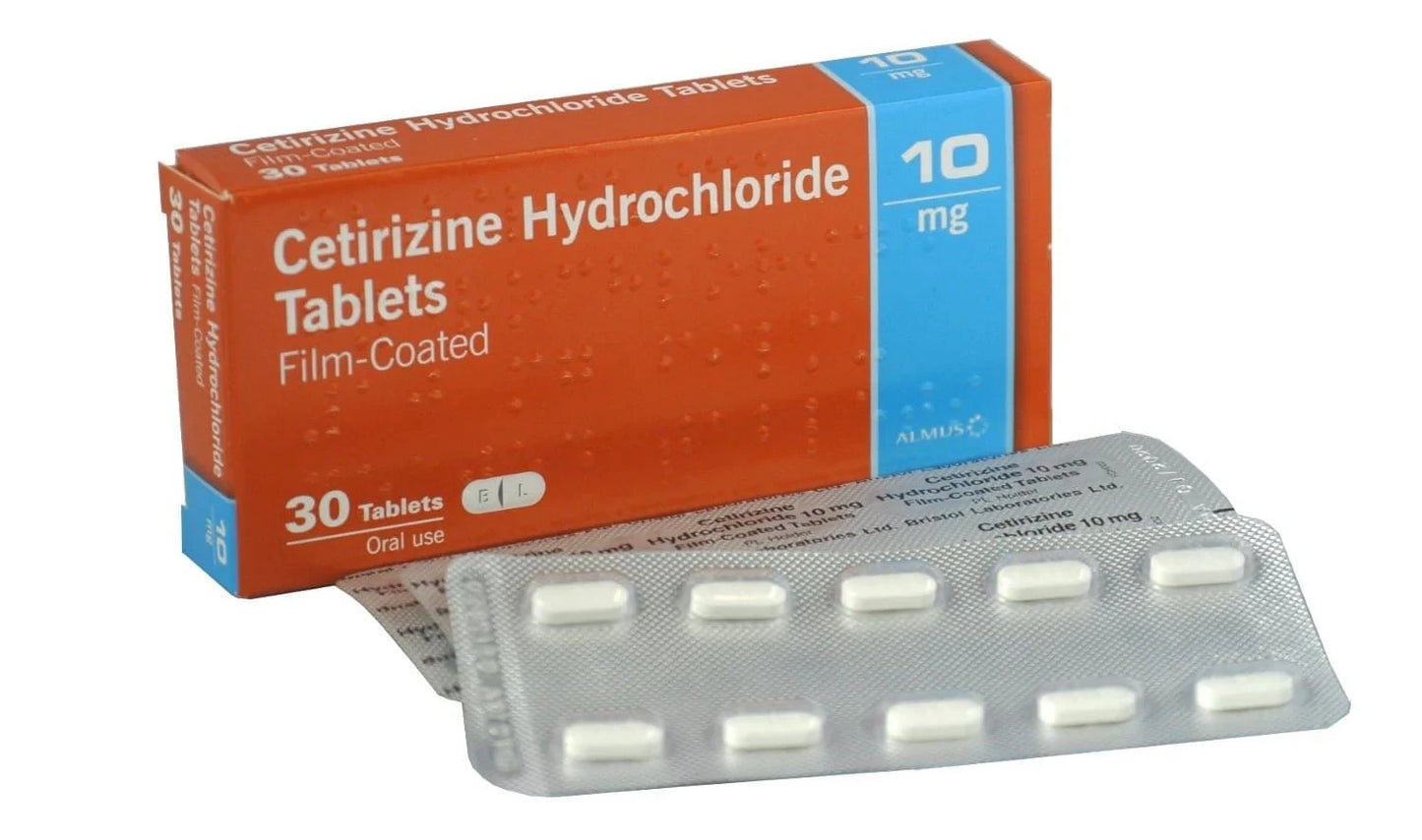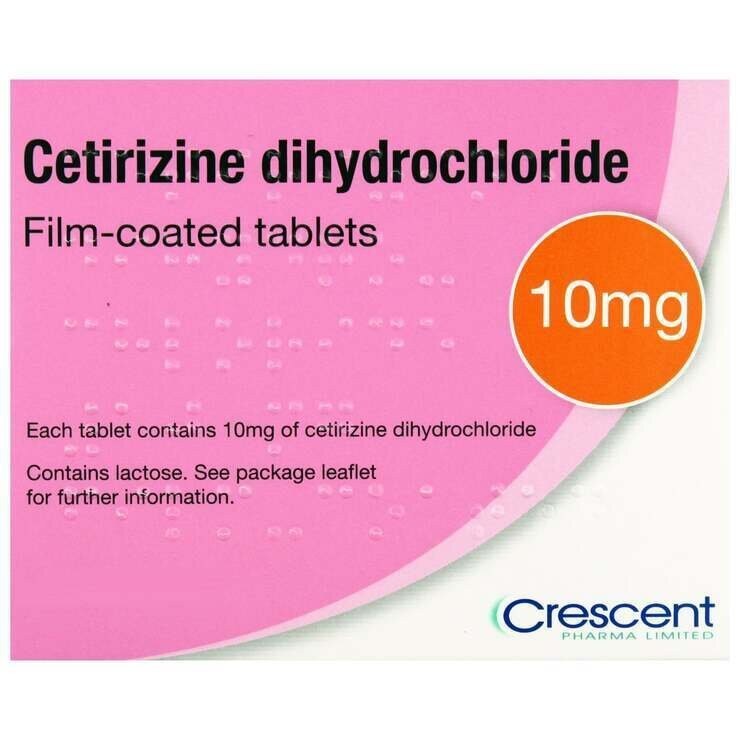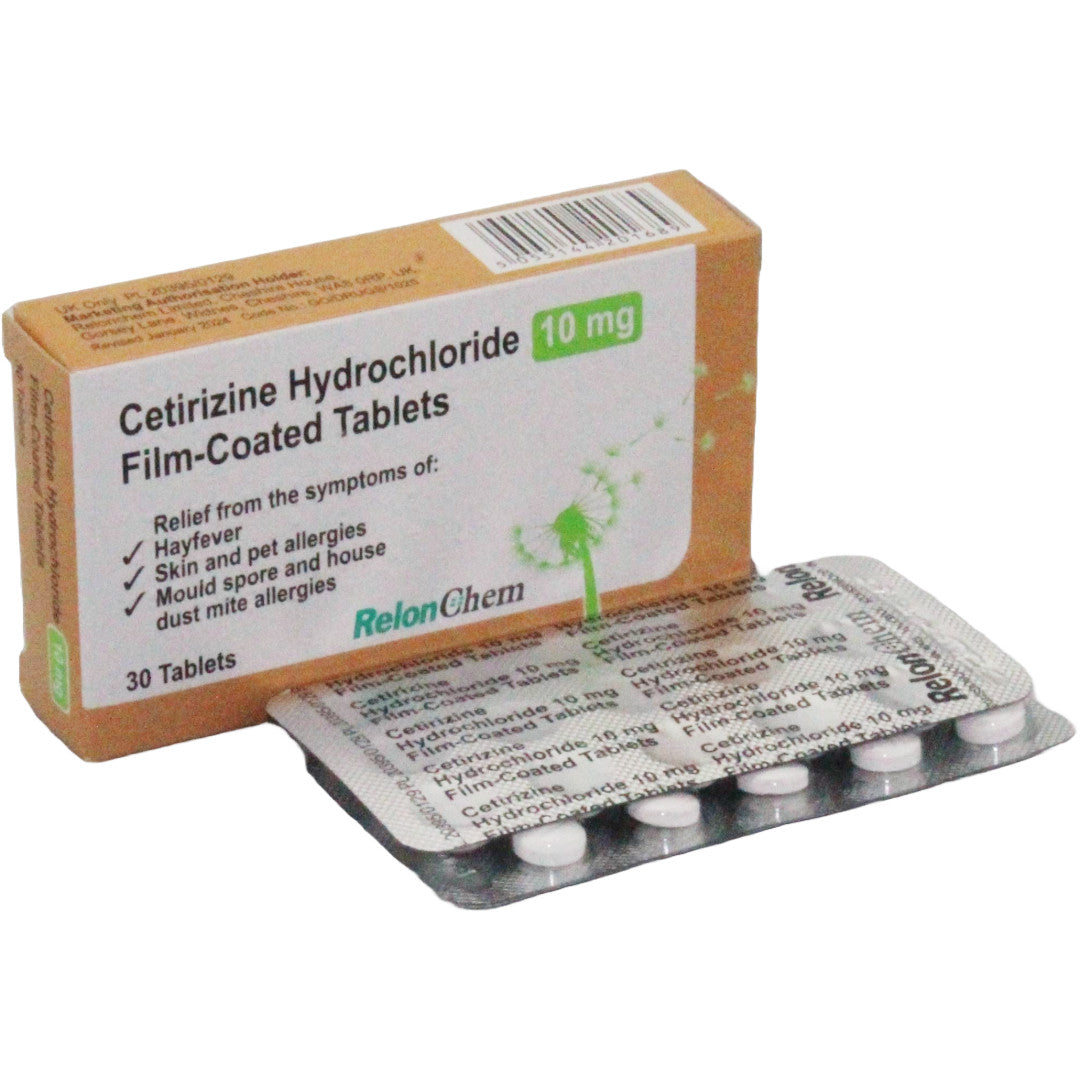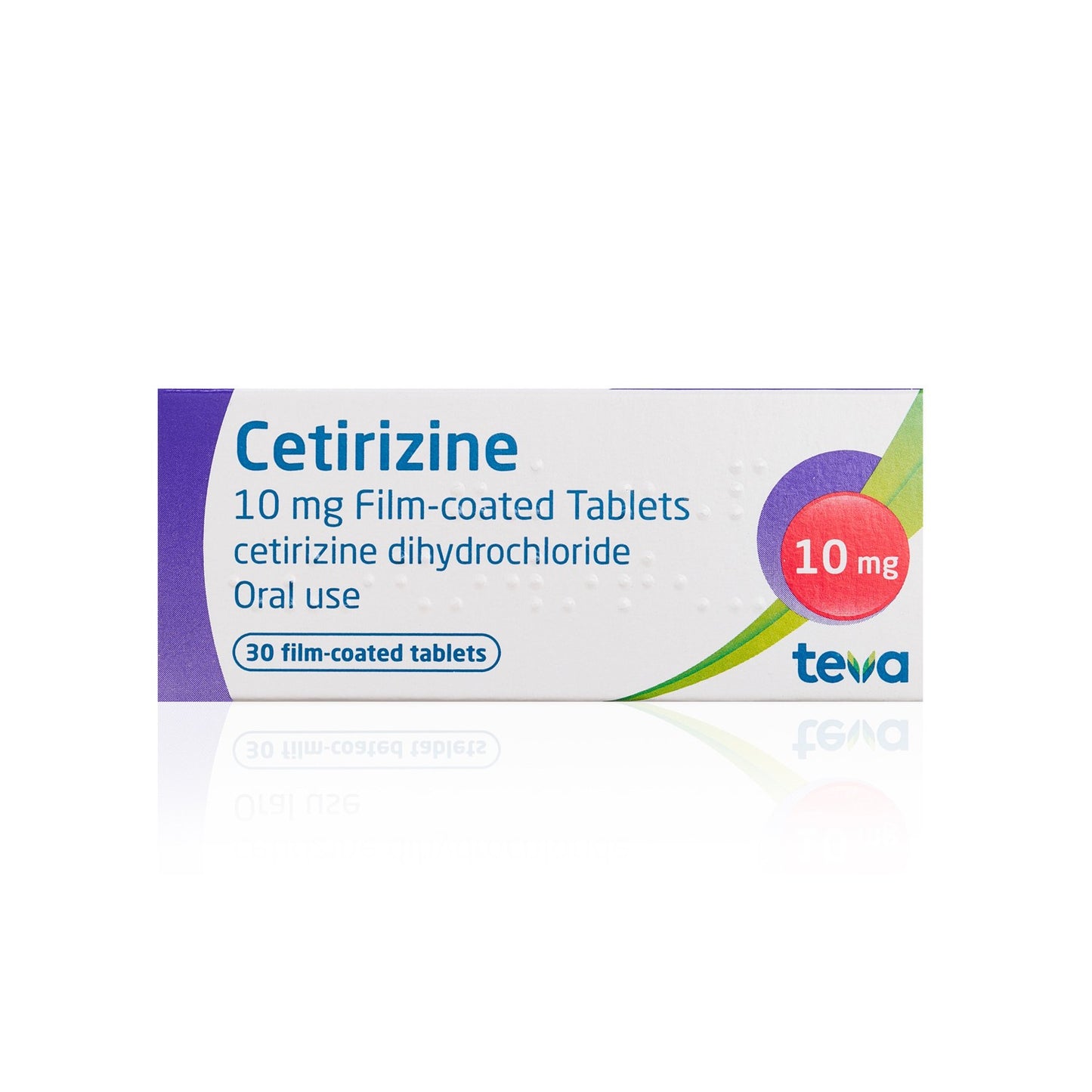1
/
of
4
J H Williams Chemists
Cetirizine 10mg - *Choose Quantity* Hayfever Relief Brand May Vary
Cetirizine 10mg - *Choose Quantity* Hayfever Relief Brand May Vary
Regular price
£3.99 GBP
Regular price
£3.99 GBP
Sale price
£3.99 GBP
Taxes included.
Quantity
Couldn't load pickup availability
Cetirizine 10mg Tablets – *Choose Quantity | Hayfever, Allergy & Skin Reaction Relief | Trusted UK Pharmacy Seller*
Relieve hayfever, skin allergies, pet and dust reactions fast with Cetirizine 10mg – a non-drowsy antihistamine trusted for daily allergy control.
---
💊 Key Benefits:
✔️ Effective for hayfever, hives, pet/dust allergies & insect bites
✔️ Non-drowsy formula (in most people)
✔️ Suitable for adults & children 6+
✔️ Long-lasting 24-hour relief
✔️ Brand may vary depending on stock (e.g. Piriteze, Galpharm, Accord, etc.)
---
📦 Product Info:
- Strength: 10mg
- Format: Film-coated tablets
- Quantity: Choose from dropdown
- Expiry: Minimum 1 year+
- UK licensed medicine
- Condition: Brand New & Sealed
---
📮 Delivery:
- Fast & Free UK Delivery
- Same Day Dispatch (Mon–Fri before 2PM)
- Discreet Packaging
- Trusted UK Registered Pharmacy
---
📢 Please Note:
This is a Pharmacy Medicine. We may message you with a short suitability check before dispatch. Your order will be held confidentially and handled by our qualified pharmacy team.
---
Relieve hayfever, skin allergies, pet and dust reactions fast with Cetirizine 10mg – a non-drowsy antihistamine trusted for daily allergy control.
---
💊 Key Benefits:
✔️ Effective for hayfever, hives, pet/dust allergies & insect bites
✔️ Non-drowsy formula (in most people)
✔️ Suitable for adults & children 6+
✔️ Long-lasting 24-hour relief
✔️ Brand may vary depending on stock (e.g. Piriteze, Galpharm, Accord, etc.)
---
📦 Product Info:
- Strength: 10mg
- Format: Film-coated tablets
- Quantity: Choose from dropdown
- Expiry: Minimum 1 year+
- UK licensed medicine
- Condition: Brand New & Sealed
---
📮 Delivery:
- Fast & Free UK Delivery
- Same Day Dispatch (Mon–Fri before 2PM)
- Discreet Packaging
- Trusted UK Registered Pharmacy
---
📢 Please Note:
This is a Pharmacy Medicine. We may message you with a short suitability check before dispatch. Your order will be held confidentially and handled by our qualified pharmacy team.
---
💬 Questions? Message us — we’re happy to help!
Cetirizine Dihydrochloride 10mg - (30, 90, 180, 240,360 Tablets) Hayfever Relief
Product Description:
10mg Generic Cetirizine hayfever, Allergy Relief Tablets
Key features
This product is a generic medicine with the same active ingredient as many well know shop brands.
Cetirizine
Diydrochloride One-a-day 10mg tablets help prevent the symptoms
associated with hayfever and high pollen counts as well as other
allergic reactions caused by pets and dust mites
Cetirizine
Diydrochloride can also be taken for allergic skin reactions such as
rash, itching and urticaria (more commonly known as Hives or Nettle
Rash)
Suitable for adults and children aged 6 years and over.
The most common allergens are as follows:
The
house dust mite is one of the most common causes of allergies and no
matter how clean your house every household will have them. The warmth
and humidity in most homes is an ideal breeding environment for them,
therefore our beds are a haven for them and a single mattress can
contain up to 2 million mites. Mite allergy is caused by the mite
faeces, which when inhaled cause breathing problems (asthma) or can
irritate the skin on contact.
Pollen from grass, trees and
weeds is the second most common cause of allergies. Pollen allergies are
usually seasonal. This type of allergy is called hay fever.
The
family pet is also a common cause of an allergy. The majority of U.K.
households have a pet with 40% of asthmatic children being allergic to
cats and/or dogs. It is usually the skin/fur (animal dander) which
causes the problem.
Insects bites such as those from bees or wasps.
Foods
and drinks, such as milk, eggs, fish, wheat, soy, citrus fruits,
seafood and peanuts. Colourings and preservatives can also trigger
attacks.
Cosmetics, toiletries, jewellery and washing powders
all contain common allergens. Symptoms are typically identified by an
itchy, red rash.
Mould and mould fungus. Mould grows in damp
conditions and is obvious in houses that have damp patches on the walls
or black mould around window seals or bathrooms. Mould spores can also
be found in the soil of house plants.
Latex and rubber.
Certain medicines and drugs, such as antibiotics and anaesthetics.
What symptoms are linked with an allergy?
There
are many different types of allergies and the symptoms can vary
according to what the allergen is, how severe the reactions and what
part of the body is involved.
Common symptoms of an allergy may include:
- Attacks of sneezing or a runny nose (usually key symptoms of an allergy).
- Blocked nose and sinus pain.
- Watery, itchy eyes.
- Itchy, red rashes or inflamed skin (eczema or dermatitis).
-
Number of raised bumps or weals surrounded by red skin, which can be
itchy. This is known as urticaria, hives or nettle rash. Urticaria can
be caused by allergies to animals, foods, bee stings or medicines.
- Coughing.
- Swelling of the lips and tongue.
- Diarrhoea.
- Sickness and vomiting.
- Itchy, sore throat.
- Wheezing and shortness of breath (asthma attacks).
- Anaphylaxis, the most extreme of allergic reactions.
How many people suffer from allergies in the U.K.?
The number of people with allergies has increased dramatically over the past 20 years:
- 1 in 3 people will at some time in their life suffer from an allergy.
- 1 in 5 people suffer from hay fever (Over 9 million in the U.K. are thought to be affected).
- 1 in 5 school children are thought to be affected by asthma.
- Approximately 6 million people have eczema.
How to use
Before you take this medicine
This
medicine can be taken by adults and children aged 6 years and over.
However, some people should not take this medicine or should seek the
advice of their pharmacist or doctor first. Please view the section on
Ingredients and Precautions.
Usage
Check the foil is not broken before use. If it is, do not take that tablet.
If
your doctor has prescribed this medicine, always take Cetirizene
Dihydrochloride 10mg tablets exactly as your doctor has told you.
Otherwise follow the instructions below. You should check with your
doctor or pharmacist if you are not sure. The tablets should be
swallowed, preferably with a drink of water.
The usual dose is:
Adults and Children over 12 years of age
One Cetirizene Dihydrochloride 10mg tablet once daily.
Children aged 6 - 12 years of age:
Half a tablet, twice a day.
Children under 6 years of age
Cetirizene Diydrochloride is not recommended for children under 6 years of age.
Ingredients and Precautions
Ingredients
The active substance is cetirizine dihydrochloride.
The
other ingredients are lactose anhydrous, microcrystalline cellulose,
colloidal anhydrous silica, magnesium stearate, sodium croscarmellose,
hydroxypropylmethylcellulose (E464), polydextrose, titanium dioxide
(E171), and macrogol/polyethylene glycol 4000.
Do NOT take Cetirizene Dihydrochloride 10mg tablets If:
have severe kidney disease (severe renal failure with creatinine clearance below 10 ml/min)
are
allergic to cetirizine dihydrochloride or any of the other ingredients
(listed in section 6) or to hydroxyzine or to piperazine derivatives
(closely related active substances of other medicines)
Warnings and precautions
Talk to your doctor or pharmacist before taking Cetirizine tablets if:
you
are a patient with renal insufficiency, please ask your doctor for
advice; if necessary, you will take a lower dose. The new dose will be
determined by your doctor.
you have problems passing urine (like spinal cord problems or prostate or bladder problems), please ask your doctor for advice.
you are an epileptic patient or a patient at risk of convulsions, you should ask your doctor for advice.
No
clinically significant interactions have been observed between alcohol
(at the blood level of 0.5 per mille (g/l) corresponding to one glass of
wine) and cetirizine used at the recommended doses. However, there are
no data available on the safety when higher doses of cetirizine and
alcohol are taken together. Therefore, as it is the case with all
antihistamines, it is recommended to avoid taking Cetirizine with
alcohol.
If you are scheduled for allergy
testing, ask your doctor if you should stop taking Cetirizine for
several days before testing. This medicine may affect your allergy test
results.
Other medicines and Cetirizine tablets
Tell your doctor or pharmacist if you are taking, have recently taken or might take any other medicines.
Cetirizine tablets with food and drink
Food does not affect absorption of Cetirizine.
Pregnancy, breast-feeding and fertility
If
you are pregnant or breast-feeding, think you may be pregnant or are
planning to have a baby, ask your doctor or pharmacist for advice before
taking this medicine.
Cetirizine should be
avoided in pregnant women. Accidental use of the drug by a pregnant
woman should not produce any harmful effects on the foetus.
Nevertheless, the medicine should only be administered if necessary and
after medical advice.
Cetirizine passes into
breast milk. Therefore, you should not take Cetirizine during
breast-feeding unless you have contacted a doctor.
Driving and using machines
Clinical
studies have produced no evidence of impaired attention, alertness and
driving capabilities after taking Cetirizine at the recommended dose.
You
should closely observe your response to the drug after you have taken
Cetirizine if you are intending to drive, engage in potentially
hazardous activities or operate machinery. You should not exceed the
recommended dose.
Cetirizine tablets contains Lactose
If
you have been told by your doctor that you have an intolerance to some
sugars contact your doctor before taking this medicinal product.
If you take more Cetirizene Dihydrochloride 10mg tablets than you should
If
you think you have taken an overdose of Cetirizine please inform your
doctor. Your doctor will then decide what measures, if any, should be
taken. After an overdose, the side effects described below may occur
with increased intensity. Adverse effects such as confusion, diarrhoea,
dizziness, tiredness, headache, ailing, dilating of pupil, itching,
restlessness, sedation, somnolence, stupor, abnormal rapid heart rate,
tremors and urinary retention have been reported.
If you forget to take Cetirizine tablet
Do
not take a double dose to make up for a forgotten dose. If you forget
to take a tablet, you should take one as soon as you remember, but wait
at least 24 hours before taking your next tablet.
If you have any further questions on the use of this medicine, ask your doctor or pharmacist.
Share








